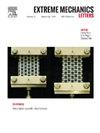Prolonged fracture resistance of hydrogels through spontaneous network reconfiguration
IF 4.5
3区 工程技术
Q2 MATERIALS SCIENCE, MULTIDISCIPLINARY
引用次数: 0
Abstract
In engineering applications, hydrogels are often susceptible to fatigue loads, either static or dynamic. Extensive efforts have been devoted to studying dynamic fatigue facture of hydrogels, which promotes the understanding of underlying mechanisms and facilitates the design and synthesis of fatigue-fracture-resistant hydrogels under cyclic loads. In stark contrast, lifetime of hydrogels under static loading is much less investigated and hydrogels resistant to delayed fracture have not been reported. Here we propose a mechanism against delayed fracture by deconcentrating stress at crack tip through spontaneous network reconfiguration, during which reversible crosslinks dissociate to relieve stress and reassociate to reconstruct the polymer network in a stress-free manner. We validate the proposed mechanism by investigating the delayed fracture behaviors of polyacrylamide hydrogels with reversible and irreversible crosslinks. We show that a hydrogel with reversible crosslinks exhibits a threshold against delayed fracture, > 132 J/m2, one order of magnitude higher than that of its counterpart with irreversible crosslinks, ∼13 J/m2, which obeys the Lake-Thomas prediction. We provide further validations, including experimental observations on training-enhanced fracture stretch, decreased threshold for delayed fracture at a lower rate of network reconfiguration, prominent stress relaxation, as well as numerical simulations. Evidently, spontaneous network reconfiguration offers an effective way to deconcentrate stress at the crack tip for prolonged resistance to fracture.
通过自发网络重构延长水凝胶的抗裂性
在工程应用中,水凝胶通常容易受到静态或动态疲劳载荷的影响。人们对水凝胶的动态疲劳断裂进行了大量的研究,这有助于了解水凝胶的动态疲劳断裂机理,并有助于设计和合成循环载荷下的抗疲劳断裂水凝胶。与此形成鲜明对比的是,静载荷下水凝胶的寿命研究较少,抗延迟破裂的水凝胶也未见报道。在这里,我们提出了一种防止延迟破裂的机制,通过自发的网络重构在裂缝尖端分散应力,在此过程中可逆交联解离以释放应力并重新结合以无应力的方式重建聚合物网络。我们通过研究可逆交联和不可逆交联聚丙烯酰胺水凝胶的延迟断裂行为来验证上述机制。我们发现,具有可逆交联的水凝胶显示出延迟破裂的阈值,>; 132 J/m2,比具有不可逆交联的水凝胶高一个数量级,~ 13 J/m2,这符合Lake-Thomas预测。我们提供了进一步的验证,包括训练增强断裂拉伸的实验观察,在较低的网络重构速率下延迟断裂的阈值降低,突出的应力松弛,以及数值模拟。显然,自发网络重构提供了一种有效的方法来分散裂纹尖端的应力,从而延长抗裂性。
本文章由计算机程序翻译,如有差异,请以英文原文为准。
求助全文
约1分钟内获得全文
求助全文
来源期刊

Extreme Mechanics Letters
Engineering-Mechanics of Materials
CiteScore
9.20
自引率
4.30%
发文量
179
审稿时长
45 days
期刊介绍:
Extreme Mechanics Letters (EML) enables rapid communication of research that highlights the role of mechanics in multi-disciplinary areas across materials science, physics, chemistry, biology, medicine and engineering. Emphasis is on the impact, depth and originality of new concepts, methods and observations at the forefront of applied sciences.
 求助内容:
求助内容: 应助结果提醒方式:
应助结果提醒方式:


